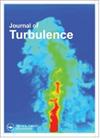Convolutional neural network models and interpretability for the anisotropic reynolds stress tensor in turbulent one-dimensional flows
IF 1.6
4区 工程技术
Q3 MECHANICS
引用次数: 8
Abstract
The Reynolds-averaged Navier-Stokes (RANS) equations are widely used in turbulence applications. They require accurately modelling the anisotropic Reynolds stress tensor, for which traditional Reynolds stress closure models only yield reliable results in some flow configurations. In the last few years, there has been a surge of work aiming at using data-driven approaches to tackle this problem. The majority of previous work has focused on the development of fully connected networks for modelling the anisotropic Reynolds stress tensor. In this paper, we expand upon recent work for turbulent channel flow and develop new convolutional neural network (CNN) models that are able to accurately predict the normalised anisotropic Reynolds stress tensor. We apply the new CNN model to a number of one-dimensional turbulent flows. Additionally, we present interpretability techniques that help drive the model design and provide guidance on the model behaviour in relation to the underlying physics.湍流一维流动中各向异性雷诺应力张量的卷积神经网络模型及其可解释性
雷诺平均Navier-Stokes(RANS)方程在湍流应用中得到了广泛的应用。它们需要对各向异性雷诺应力张量进行精确建模,而传统的雷诺应力闭合模型只能在某些流动配置中产生可靠的结果。在过去的几年里,旨在使用数据驱动的方法来解决这个问题的工作激增。以前的大部分工作都集中在开发用于各向异性雷诺应力张量建模的全连接网络上。在本文中,我们扩展了湍流通道流的最新工作,并开发了能够准确预测归一化各向异性雷诺应力张量的新卷积神经网络(CNN)模型。我们将新的CNN模型应用于许多一维湍流。此外,我们还介绍了可解释性技术,这些技术有助于推动模型设计,并为与底层物理相关的模型行为提供指导。
本文章由计算机程序翻译,如有差异,请以英文原文为准。
求助全文
约1分钟内获得全文
求助全文
来源期刊

Journal of Turbulence
物理-力学
CiteScore
3.90
自引率
5.30%
发文量
23
审稿时长
6-12 weeks
期刊介绍:
Turbulence is a physical phenomenon occurring in most fluid flows, and is a major research topic at the cutting edge of science and technology. Journal of Turbulence ( JoT) is a digital forum for disseminating new theoretical, numerical and experimental knowledge aimed at understanding, predicting and controlling fluid turbulence.
JoT provides a common venue for communicating advances of fundamental and applied character across the many disciplines in which turbulence plays a vital role. Examples include turbulence arising in engineering fluid dynamics (aerodynamics and hydrodynamics, particulate and multi-phase flows, acoustics, hydraulics, combustion, aeroelasticity, transitional flows, turbo-machinery, heat transfer), geophysical fluid dynamics (environmental flows, oceanography, meteorology), in physics (magnetohydrodynamics and fusion, astrophysics, cryogenic and quantum fluids), and mathematics (turbulence from PDE’s, model systems). The multimedia capabilities offered by this electronic journal (including free colour images and video movies), provide a unique opportunity for disseminating turbulence research in visually impressive ways.
 求助内容:
求助内容: 应助结果提醒方式:
应助结果提醒方式:


